Contents
Market Overview
Macro Review
We have lift-off. The FOMC hiked 25bp for the first time since 2018, just the BOE hiked for a third time and the ECB seem set for lift-off in early 2H. Chair Powell also said the Fed expected to reduce the size of its balance sheet at ‘a coming meeting’. The dots now point to a year-end rate of 1.9% and imply seven hikes over the next six meetings, hence consensus is shifting to a 50bp hike in May. A 50bp increase is already supported by the Fed’s Bullard, but increasingly from Waller who stated a 50bp hike at ‘one or multiple meetings’. Brazil also hiked 100bp as inflation shows few signs of slowing, although the pace of tightening is expected to slow considerably after the next Copom meeting in May. The BRL is comfortably the top performing EMFX pair year-to-date as well. The focus clearly remained on whether Russia would default on its sovereign debt over the past week. The U.S. allowed Russia to use frozen reserves to pay the USD coupon on the 2023 and 2043 notes. While it seemed that this may have staved off default, there had been some ambiguity over whether investors actually received the interest payments. The next test comes on Monday, although this USD instrument has the “alternative payment currency event” clause, meaning the coupon can be paid in RUB, EUR, CHF or CBP, but it requires a 15-day notice, which the Ministry of Finance has not published. Further complications come as capital controls prevented payment on foreign-owned Russian local bond exposure that is said to have already been in default, but it hasn’t cross-defaulted into the other Russian sovereign debt (yet).
EM Credit Update
Emerging market sovereign credit ended the week up 1.8% in its best week since November 2020. Credit spreads rallied 42bp. Outperformers over the week were Belarus, Russia, and Ukraine, while Tunisia, Georgia, and Ethiopia underperformed. Other than a sharp rally, we also note that the EM sovereign primary issuance market reopened. Two single B issuers were able to borrow, as Nigeria issued a 7-year bond and Turkey issued a 5-year bond, which follows in the footsteps of Chile’s sustainability-linked bond four weeks ago.
The Week Ahead
NATO members are set to meet in Brussels next week which remains the key event. However, in Asia the main event is whether China will cut its LPR rate by 25bp and begin the gradual easing cycle, although it is unlikely, as much as a 50bp RRR cut. Beyond that, interest rate decisions are due from Egypt (8.25%), Hungary (3.4%), Mexico (6.0%), Nigeria (11.5%), Philippines (2.0%) and South Africa (4.0%). Inflation out of Brazil will also be key after the recent 100bp hike, followed by Hong Kong and South Africa. Finally, Argentina is set to publish 4Q GDP growth and the UK will be out with the “Spring Statement” as the Chancellor of the Exchequer outlines public spending plans.
Highlights from emerging markets discussed below include: Hopes for a quick negotiated end to military conflict in Ukraine appear premature; Argentina passed IMF program financing in Congress; Presidential primaries in Colombia confirm left-wing Petro’s frontrunner status and signal a polarized election in May/June against the Centre-Right; a fragmented Congress points to transactional policymaking when a new administration takes office in August; Peru’s Congress accepted motion to debate impeachment of Castillo; Global emerging markets corporates in focus: Regulating non-bank financial institutions (NBFIs)
Fixed Income
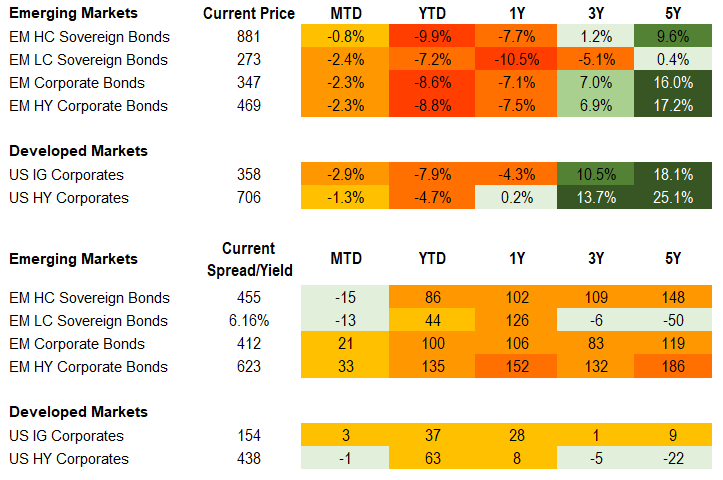
Equities
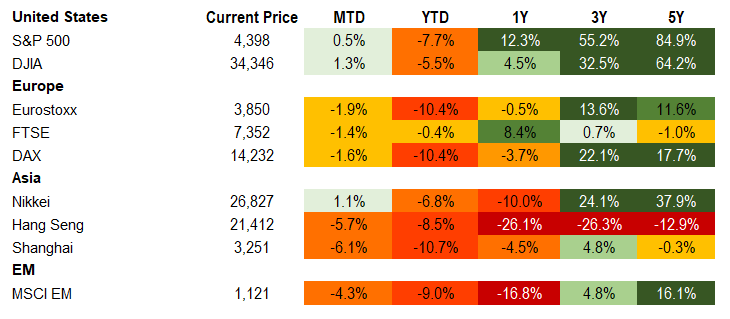
Commodities

Source for data tables: Bloomberg, JPMorgan, Gramercy. EM Fixed Income is represented by the following JPMorgan Indicies: EMBI Global, GBI-EM Global Diversified, CEMBI Broad Diversified and CEMBI Broad High Yield. DM Fixed Income is represented by the JPMorgan JULI Total Return Index and Domestic High Yield Index. Fixed Income, Equity and Commodity data is as of March 18, 2022 (mid-afternoon).
Emerging Markets Weekly Highlights
Hopes for a quick negotiated end to military conflict in Ukraine appear premature
Event: The Financial Times (FT) published an article that Ukraine and Russia might be close to agreeing on a “fifteen-point draft deal” to end the conflict, which induced a breath of optimism into global markets mid-way this week. Meanwhile, Russian forces continue shelling Ukrainian population centers and appear to be regrouping for a potential ground offensive against Kyiv. A rocket attack against a Ukrainian army training facility 20km from Poland’s border brought fighting closer to NATO territory.
Gramercy Commentary: We are skeptical about ceasefire and peace agreement prospects at this stage of the conflict. The military situation on the ground (that we can describe as “mixed” at best) from Russia’s perspective and the Kremlin’s stated objectives of its invasion, point to a continuation of active fighting regardless of parallel diplomatic discussions. The Zelensky Administration has signaled flexibility on the issue of neutrality/not joining NATO, but Russia’s territorial demands over Crimea and independence of the separatist regions in Eastern Ukraine remain unacceptable to Kyiv. As such, we think that market optimism as reflected by recent asset price dynamics is premature. In fact, both sides have poured cold water on expectations of a quick ceasefire. Ukrainian negotiators signaled that the “draft deal” published by the FT reflects Russia’s starting positions as opposed to any sort of negotiated outcome, while the Kremlin said that reports of major progress in Ukraine talks are “wrong”. We believe that President Putin retains rather maximalist objectives in his military gamble in Ukraine. Given the already catastrophic impact for Russia’s economy, increasing global isolation, and even some initial tentative uncertainty about his domestic political standing over the medium-term, he appears to have little choice but to continue pushing for a better position on the ground before engaging in more substantive peace talks. As such, unless there is a significant breakthrough in ceasefire negotiations in the coming days and a direct meeting between Presidents Zelensky and Putin comes on the table, we believe a ground offensive to capture Kyiv is a likely next phase in the conflict. Ukraine’s capital is well fortified and defended by highly capable and motivated forces, which unfortunately points to a bloody protracted battle, more civilian refugees, and significant further infrastructure damage. Meanwhile, large financial and military support from the West continues to flow towards the Zelensky Administration, with a large new batch of sophisticated lethal defense systems provided by the U.S. this week, including military drones.
Argentina passed IMF program financing in Congress
Event: The lower and upper chambers of Congress passed the IMF bill to refinance the government’s outstanding $45bn in maturities to the Fund. Support in the Senate and House was roughly 80% in favor albeit with the highest level of votes against the bill from the ruling FdT coalition. Relatively swift IMF Board approval is expected next week ahead of the March 22nd payment. The gap between the parallel blue chip swap rate and official FX rate has narrowed to around 80%. Meanwhile, February CPI printed high relative to expectations at 4.7% m/m and 52.3% y/y with broad based price pressure particularly in food, clothing, restaurants and hotels.
Gramercy Commentary: Finalization of the IMF agreement is a credit positive as it avoids a disruptive arrears scenario with the Fund and Paris Club. Markets will now focus on execution amid a still splintered political backdrop. Given that the congressional approval obtained was specific to the financing aspect of the IMF deal rather than the underlying policies, prospect for noise over implementation remains high with the first hurdle being passage of a revised 2022 budget by April 15th as well as a public hearing on subsidy plans in the backdrop of an increasingly challenging inflation environment with little respite in sight. While we see the IMF’s 2022 inflation target range of 38-48% as very ambitious and anticipate substantially lower subsidy-related fiscal savings estimated in the pre-war staff level report, we do not necessarily see slippage on these fronts in the near-term as disruptive to disbursements amid global pressures and likely desire to at least get the program off the ground.
Presidential primaries in Colombia confirm left-wing Petro’s frontrunner status and signal a polarized election in May/June against the Centre-Right; a fragmented Congress points to transactional policymaking when a new administration takes office in August
Event: Congressional elections and primaries within the three main political coalitions participating in the presidential elections (scheduled for May/June) took place in Colombia last weekend. In the presidential primaries, the largest share of primary voters participated in the left-wing Pacto Histórico’s primary (47%), followed by the centre-right Coalición Equipo por Colombia’s (34%), while centre-left Coalición Centro Esperanza attracted the smallest share (19%). As for Congress, left and centre-left political forces made major gains, increasing their share of seats to 46% from 37% in the Senate and 50% from 35% in the Lower House.
Gramercy Commentary: Last Sunday’s results confirmed left-wing Senator Gustavo Petro’s momentum and frontrunner status in the presidential race. Petro appears on track to be one of the two candidates that will compete in a second-round runoff on June 19th, in case no candidate receives the majority of the vote in the first round on May 29th. Now that the primaries have produced a more defined race and Petro is no longer the only “viable” candidate, polls going forward should give markets better signals on which candidate could emerge as the main challenger and the relative probabilities of different election scenarios. Based on the primaries’ results, one runoff scenario that appears likely is between Petro and Federico Gutierrez, the winner of the center-right primary. This is a scenario that suggests highly polarized pre-election campaigns in which centrist and undecided Colombian voters would need to make a difficult choice between supporting potential more radical economic policies under left-wing Petro or a candidate associated with the current highly unpopular right-wing Duque Administration. Petro seems to be holding a structural advantage in such a scenario as “demand for change” sentiment appears to be strong. However, one silver lining for the center of the political spectrum from last Sunday’s primaries results is that more voters participated in the two centrist primaries (6.4m) than in Petro’s (5.5m). In that context, the chances of centrist forces to defeat Petro would likely hinge on their ability to ultimately coalesce convincingly around a strong anti-Petro candidacy and attract many of those voters who are still undecided. In that sense, the choice of running mates might prove critical for both Petro and Gutierrez, so markets will be keenly following developments on that front in the coming days. Other candidates such as independents Rodolfo Hernandez (populist) and Ingrid Betancourt (environmentalist) could also get involved in the race for the second spot in a probable June run-off against Petro for the presidency. As for Congress, the elections produced a highly fragmented legislative body, which was in line with expectations. Left and center-left parties made significant gains, largely at the expense of President Duque’s ruling right-wing party, but the balance in the upper house remained slightly in favor of right and center-right forces (54% vs 46%). With this legislative backdrop, coalition building is not going to be easy, so economic policy implementation by whoever the next president will be is likely to depend on transactional politics and encounter significant gridlock. As such, we expect Congress’s counterbalance, as well as Colombia’s traditionally strong institutions, to limit potential economic policy initiatives that could be considered “radical” by markets. Similarly, meaningful market-friendly structural reforms such as continuation of fiscal reforms needed to stabilize sovereign debt dynamics and decrease Colombia’s large twin deficits would also likely prove challenging.
Peru’s Congress accepted motion to debate impeachment of Castillo
Event: On Monday, Congress voted to debate the most recent impeachment motion against President Castillo with 76 votes (vs. 52 votes required and 130 votes total). The hearing and vote for dismissal, which requires support of 87 lawmakers, is scheduled to be held on March 28th.
Gramercy Commentary: The effort to oust Castillo is in line with our expectation for ongoing political tensions and momentum towards eventual vacancy, although it remains uncertain that Congress has the support to impeach him just yet. In the event he is removed, Vice President Dina Boluarte would assume office with a decent probability for her resignation or ouster. Thereafter, the head of Congress, Maricarmen Alva, would take over and likely call for a presidential or general election with legal uncertainty over which is required. We expect political tensions and governability challenges to remain elevated, weighing on investment growth. However, for the time being, beneficial terms of trade in the backdrop of the ongoing commodity shock and still orthodox teams at MEF and BCRP continue to provide an anchor for Peruvian assets.
Global emerging markets corporates in focus: Regulating non-bank financial institutions (NBFIs)
Event: The Brazilian Central Bank recently announced new regulations governing payment institutions. These rules, in some cases, vary according to the size and complexity of the institutions. There have been discussions about new rules for these issuers for some time, so the disclosure was not a surprise. More broadly, new requirements faced by these non-bank financial institutions may again raise questions about the different regulatory regimes which are applicable to operators in the financial sector.
Gramercy Commentary: NBFIs such as payment service providers can play a vital role in improving financial inclusion by reaching sectors and clients which traditional banks may overlook. A number of these institutions are more technology-driven than typical banks. As such, NBFIs can sometimes help drive innovation in the financial sector, promoting faster and more efficient transactions. These issuers may also promote competition in the financial sector, which can be positive for customers. The technology-driven entities within the NBFI sector often grow much faster than traditional banks. In some cases, these entities have become key parts of the financial systems in which they operate within a very short time. Such stellar growth may lead to concerns about what could happen in a downturn. Without the same systems and processes as traditional operators, there may be doubts about the ability of certain NBFIs to navigate significant challenges. In addition, funding sources available to NBFIs may be more limited in volatile times. These entities may not collect deposits and may not have access to central bank liquidity. More regulation could well mean there is access to more funding sources. Such regulation can also play a role in planning for upcoming maturity payments and can improve comparability of metrics amongst issuers. In addition, regulatory oversight of NBFIs may decrease risks for the financial sector, with supervisors able to monitor these risks as they emerge in all parts of the sector, potentially preventing contagion effects. Having said all this, regulation is not infallible – financial institutions have and may still fail, even where closely regulated. Further, what works in one jurisdiction may not in another. Nonetheless, in assessing the varied participants classed as NBFIs, the regulatory framework (or lack thereof) can play a significant role.
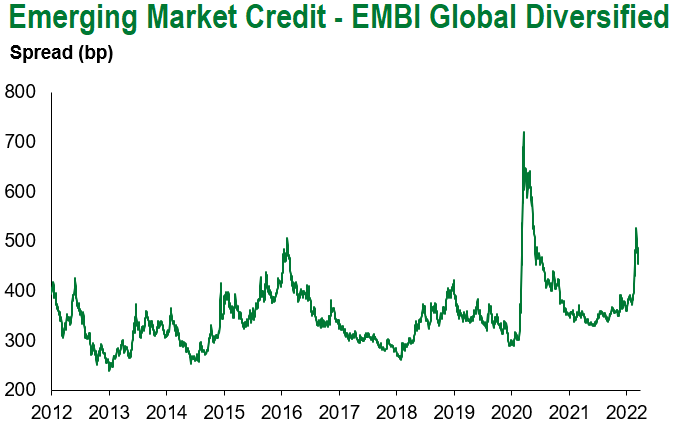
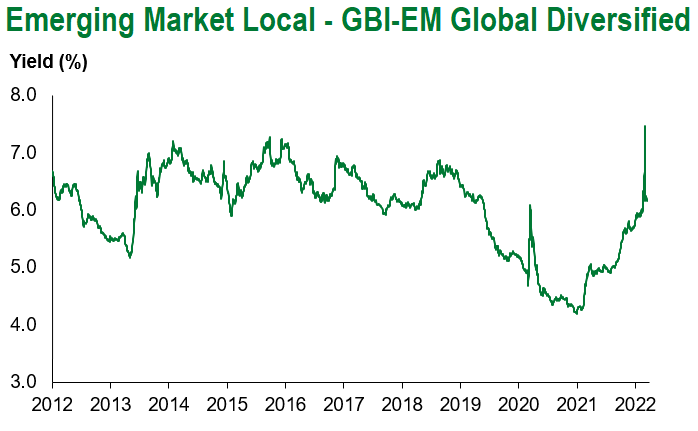
Emerging Markets Technicals
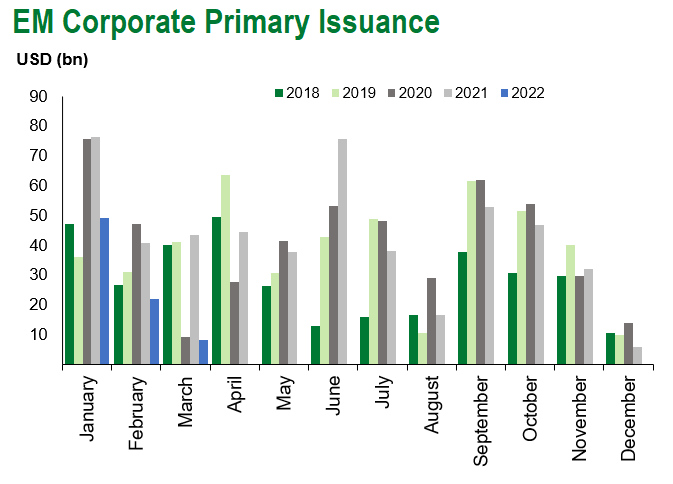
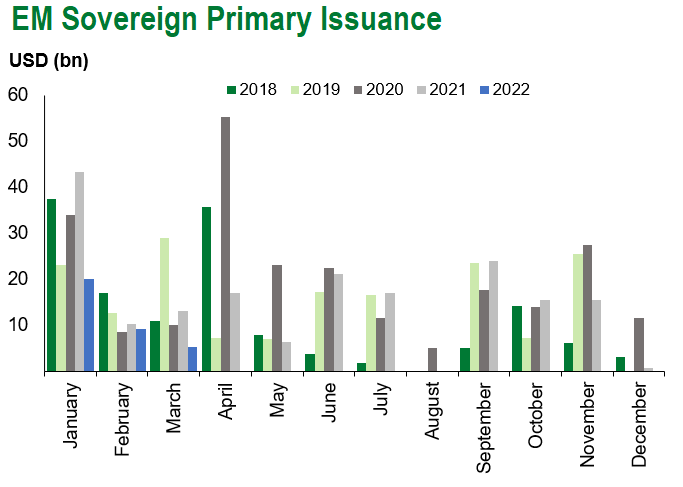
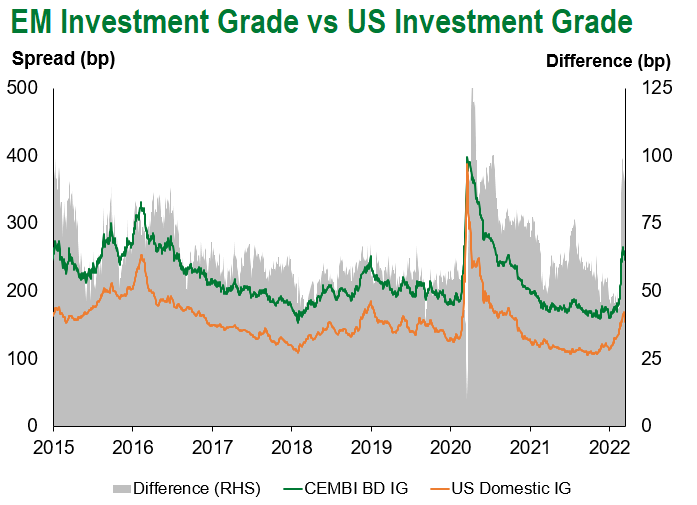
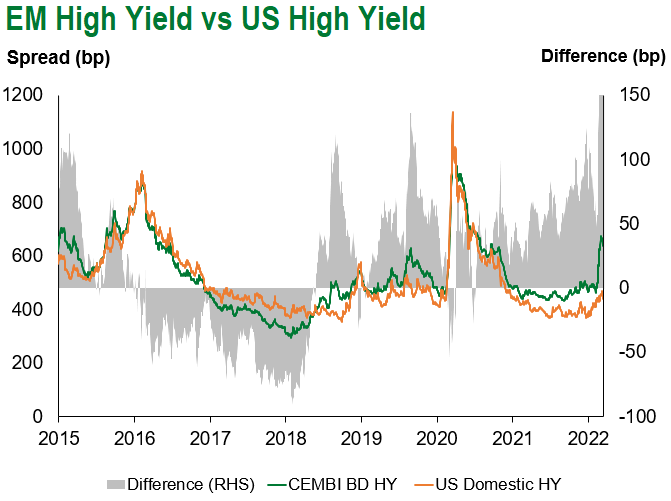
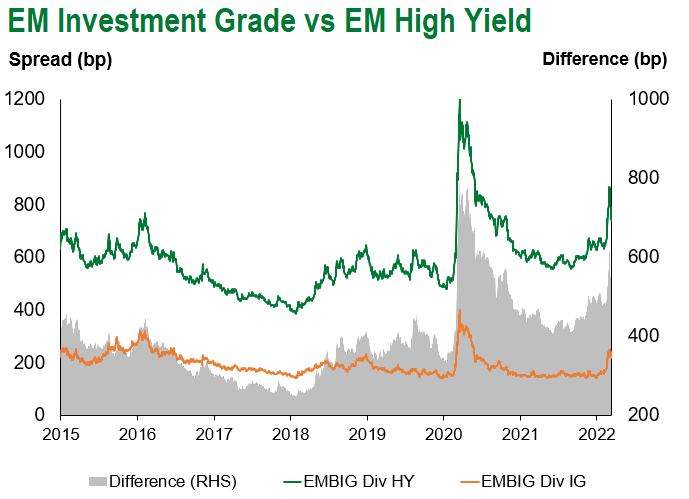
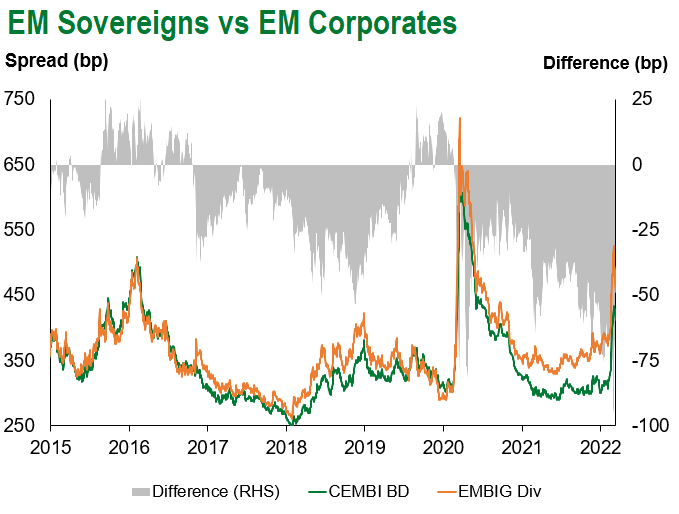
Emerging Markets Flows
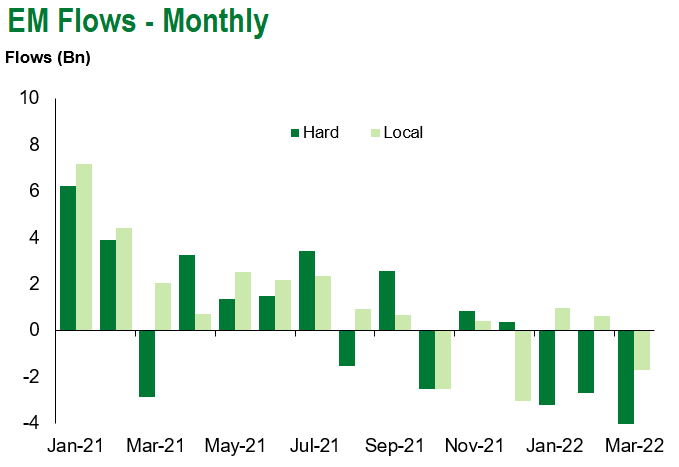
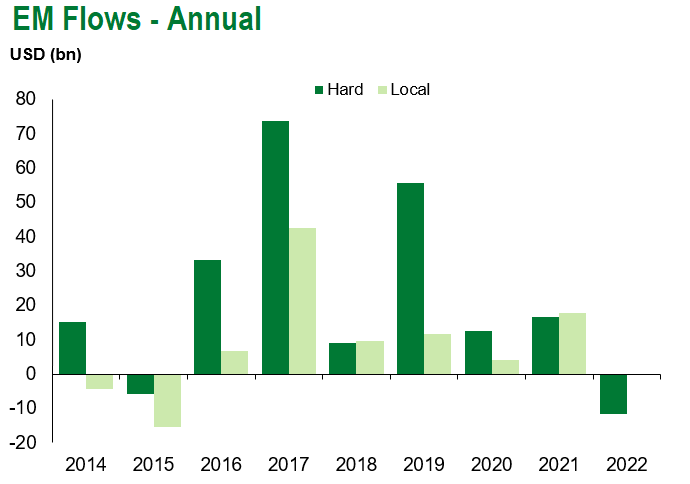
Source for graphs: Bloomberg, JPMorgan, Gramercy. As of March 18, 2022.
COVID Resources
Emerging Markets COVID-19 Case Summary
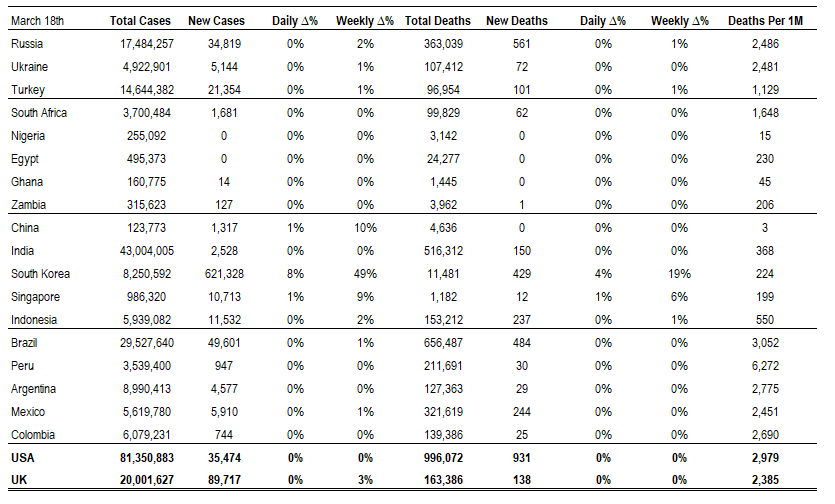
Source: Worldometer as of March 18, 2022.
Additional Crisis Resources:
Johns Hopkins COVID-19 Case Tracker
For questions, please contact:
Kathryn Exum, CFA ESG, Senior Vice President, Sovereign Research Analyst, [email protected]
Petar Atanasov, Senior Vice President, Sovereign Research Analyst, [email protected]
Tolu Alamutu, CFA, Senior Vice President, Corporate Research Analyst, [email protected]
James Barry, Vice President, Corporate Research Analyst, [email protected]
This document is for informational purposes only. The information presented is not intended to be relied upon as a forecast, research or investment advice, and is not a recommendation, offer or solicitation to buy or sell any securities or to adopt any investment strategy. Gramercy may have current investment positions in the securities or sovereigns mentioned above. The information and opinions contained in this paper are as of the date of initial publication, derived from proprietary and nonproprietary sources deemed by Gramercy to be reliable, are not necessarily all-inclusive and are not guaranteed as to accuracy. This paper may contain “forward-looking” information that is not purely historical in nature. Such information may include, among other things, projections and forecasts. There is no guarantee that any forecasts made will come to pass. Reliance upon information in this paper is at the sole discretion of the reader. You should not rely on this presentation as the basis upon which to make an investment decision. Investment involves risk. There can be no assurance that investment objectives will be achieved. Investors must be prepared to bear the risk of a total loss of their investment. These risks are often heightened for investments in emerging/developing markets or smaller capital markets. International investing involves risks, including risks related to foreign currency, limited liquidity, less government regulation, and the possibility of substantial volatility due to adverse political, economic or other developments. The information provided herein is neither tax nor legal advice. Investors should speak to their tax professional for specific information regarding their tax situation.